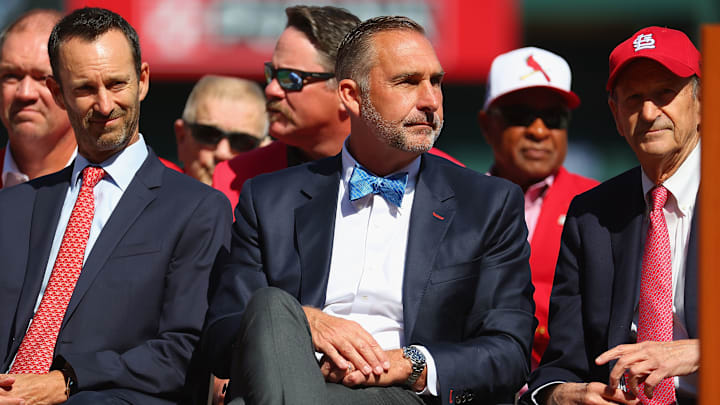When I heard that Victor Scott needed more “seasoning” in the minor leagues, I had to check my calendar and make sure this was 2024. This is an era where the 11th pick in last year’s draft, Nolan Schanuel, spent 21 days in the minors, and the World Series-winning Texas Rangers have just announced that Wyatt Langford made their team after only 44 games in the minor leagues. The San Diego Padres promoted Ethan Salas to Double-A at age seventeen. One has to wonder if baseball is changing and the St. Louis Cardinals haven’t gotten the memo yet.
Of course, Scott ended up making the Opening Day roster, but that was due to another injury in the outfield.
MLB released their 2024 minor league rankings and placed the Cardinals 23rd. The other four teams in the division were all in the top 10. To make things even worse, the average age of the top thirty Cardinals minor league players is 22.2. The average age of the division rival Reds, Cubs, Pirates, and Brewers is 20.9. The top thirty overall prospects according to the MLB average 20.8. Victor Scott is twenty-three years old.
Have the Cardinals failed to change with the times?
In 1940, the Cardinals had thirty-one minor league teams. In 1968 there were nine. As recently as 2019, the Cardinals had nine minor league teams. In 2024, each MLB team now has only four minor league affiliates. According to Baseball America, there will be 450 fewer roster spots in the domestic minor leagues in 2024 than a year ago.
With less than half the minor league roster spots available to teams, the dynamics have changed. Teams no longer have the luxury of waiting years for a player to develop. With the draft, international signings, and less than half of the roster spots, there is a higher percentage of roster churn every year than ever before. Player development is now more about player refinement.
The way teams are using their levels has also changed. Triple-A has now become nothing more than an extension of the major league team. It is a place for current major league players to rehab. A place for older players looking for one more chance to play in the big leagues again, like Joey Votto. The Cardinals in recent years used triple-A as a place to shuffle players back and forth. It’s no longer a destination on the way to the majors for high-ceiling prospects.
By the time players have reached double-A, they have played on select teams throughout high school. More and more players have played in colleges that have better coaches than some minor league teams. You only need to look at the salary of a top-level college coach and the salary of a minor league manager to see the evidence of that. Colleges and some high schools have the same video rooms as the minor league teams do.
When the Cardinals drafted Victor Scott, he had played three seasons of college ball. Every year he improved. He continued the trend after being drafted. In Single-A, his batting average was .222, then .282 in A+, then .323 in Double-A. He responds well to increased challenges. The reasons he should have made this team were defense and speed. No amount of time in the minors will increase his speed and MLB grades his defense as a 70. No current player on the Cardinals roster will save more runs in the outfield or create more runs on the base paths than Scott. Spending more time in the minors will not improve either skill.
If your twenty-three-year-old player isn’t ready for the major league roster when 20.8 is the average age of a top MLB prospect, then “Houston, we have a problem.” Are they not as good as the prospects on other teams? If so, we have a serious problem with how we are drafting.
Are they truly not equipped to be a part of the major league team? I am not talking about a normal learning curve. If that is the case, we have a developmental problem and need to look at the way things are being taught in the minors. After all, the Cardinals hired Jeff Albert in part to make sure the hitting approach was the same at all levels.
When the Cardinals announced they were sending Scott back down, I never saw what he needed to work on. Speed? No. Fielding? No. Hitting? Well, the manager Oliver Marmol said, “His bat is further along than I anticipated.” He hit .290 in the minors. His work ethic? Marmol also said this, “[We] got to see the way he goes about his business, how hard he works. A very impressive individual, I’ll tell you that.” No reason other than time.
Other teams have figured out that a Double-A ball player in 2024 is sometimes better than Triple-A players. Most teams have figured out that by having more high-upside, cost-controlled players on the team like Scott, they now have more money for better free-agent signings. It’s time for the Cardinals to adjust their thinking on how to best use their minor league system.
